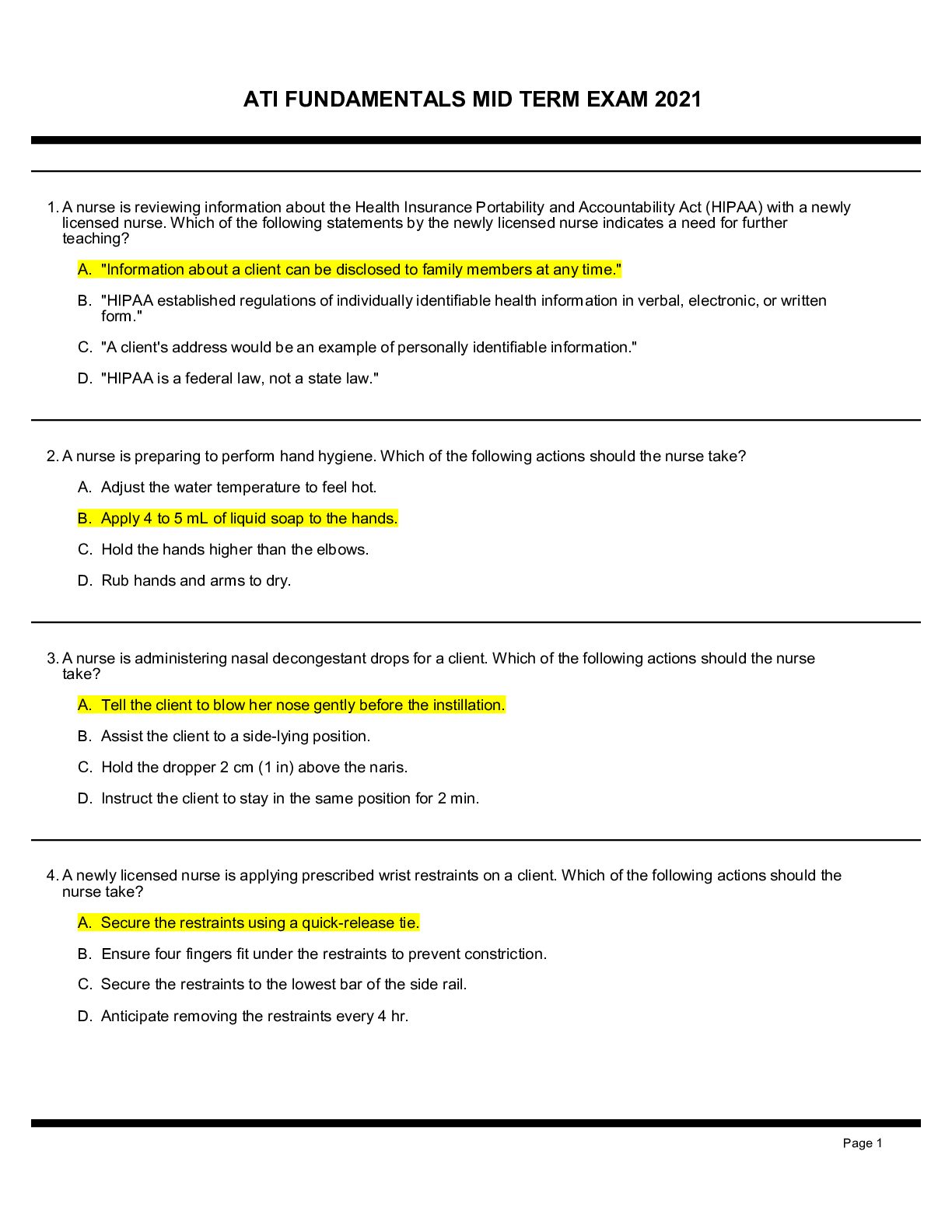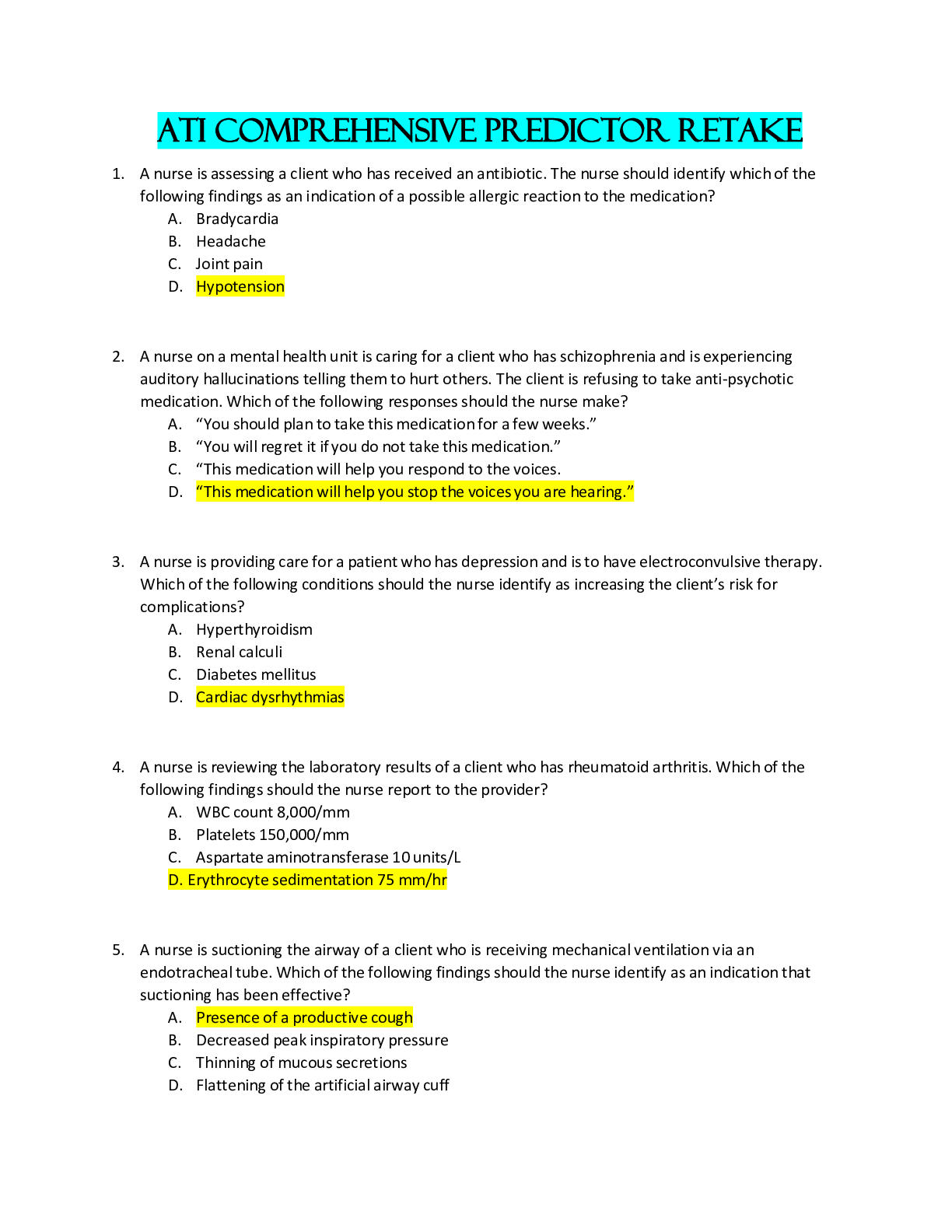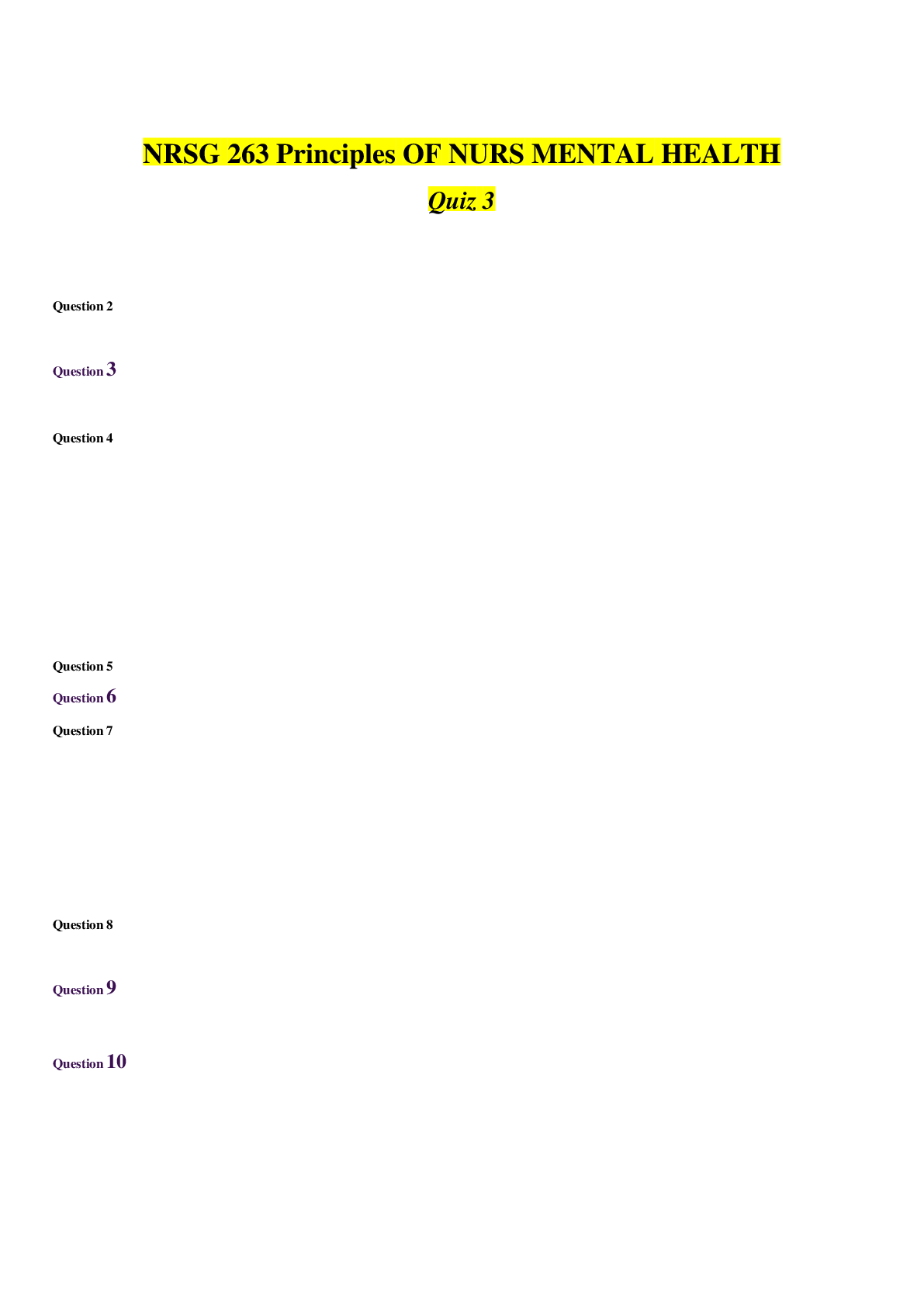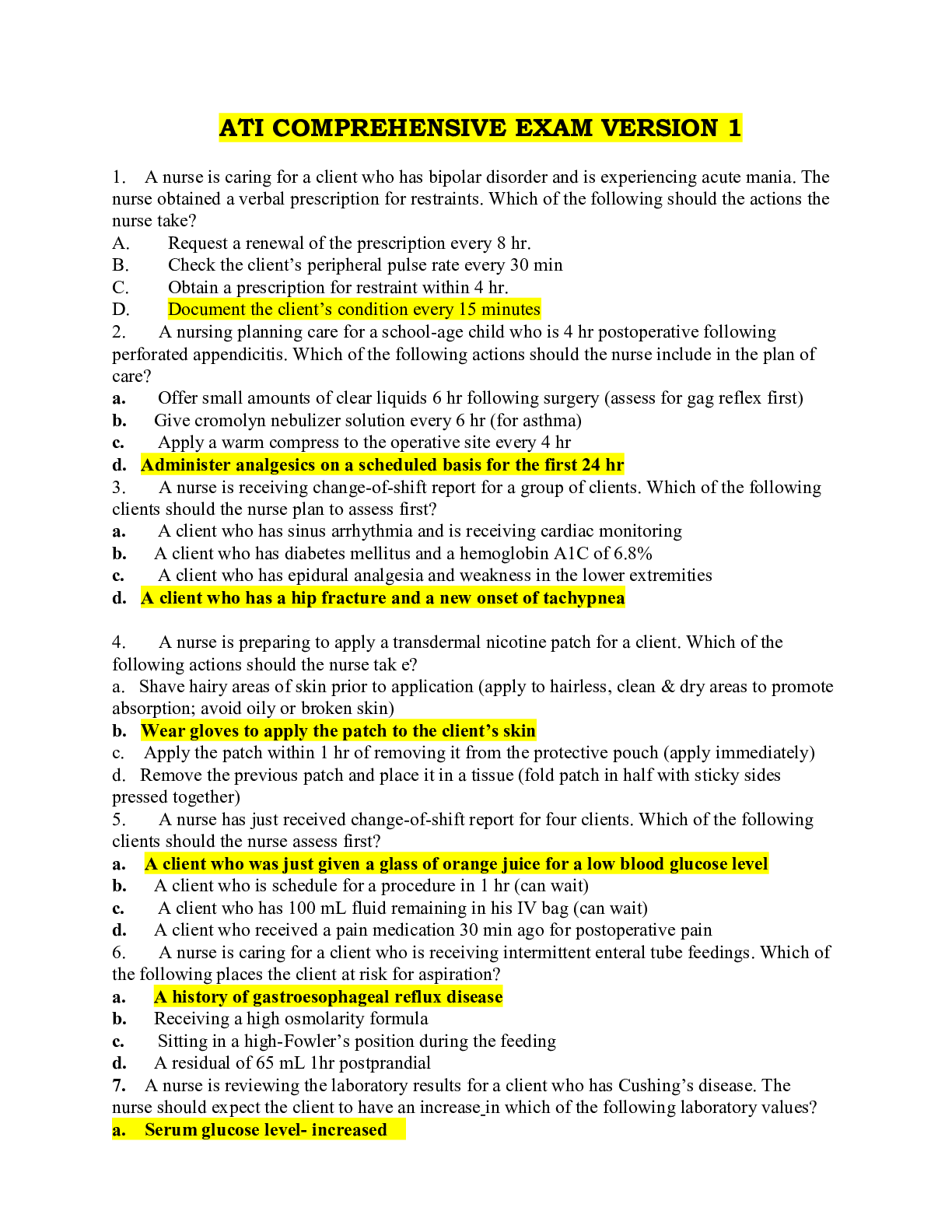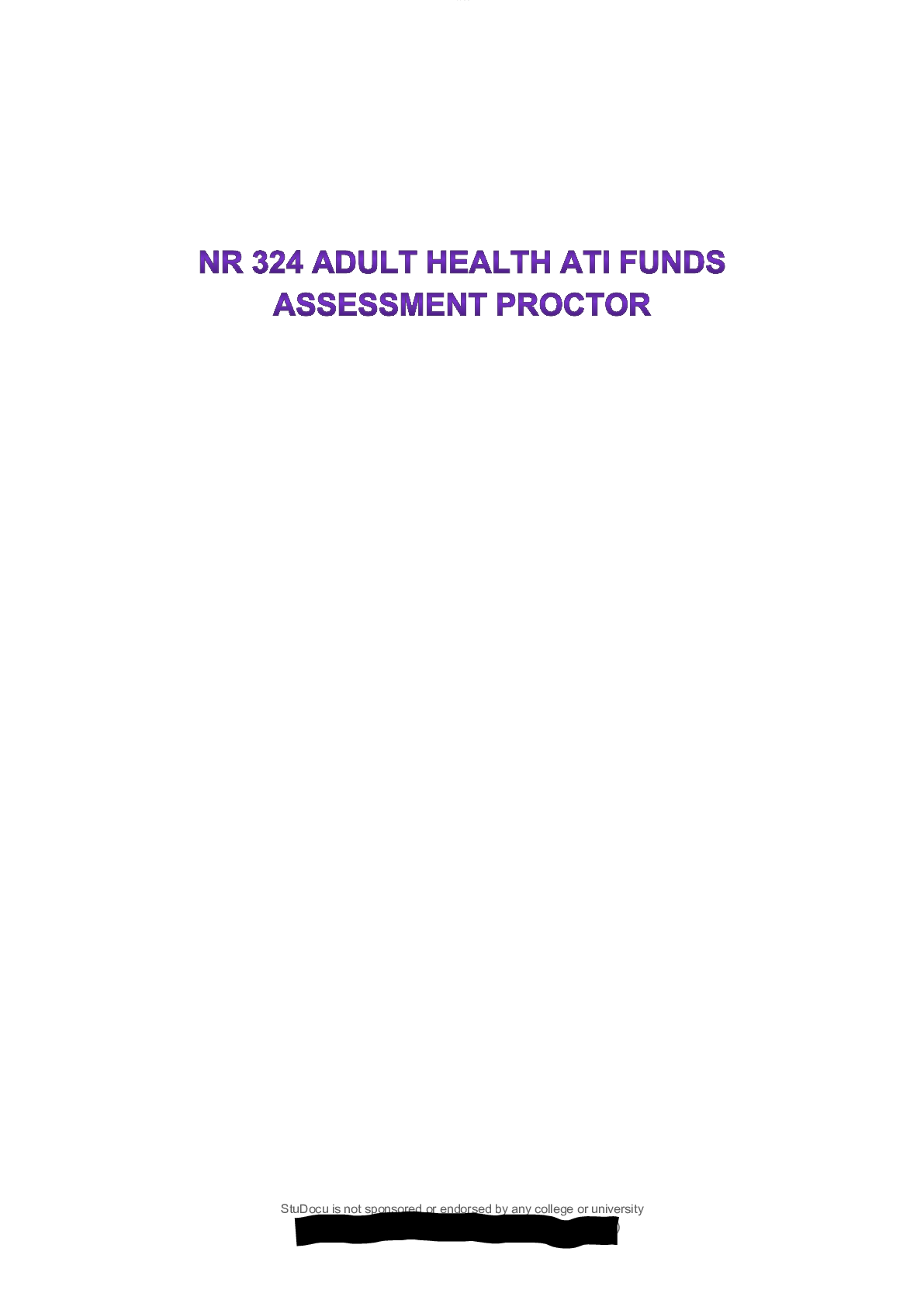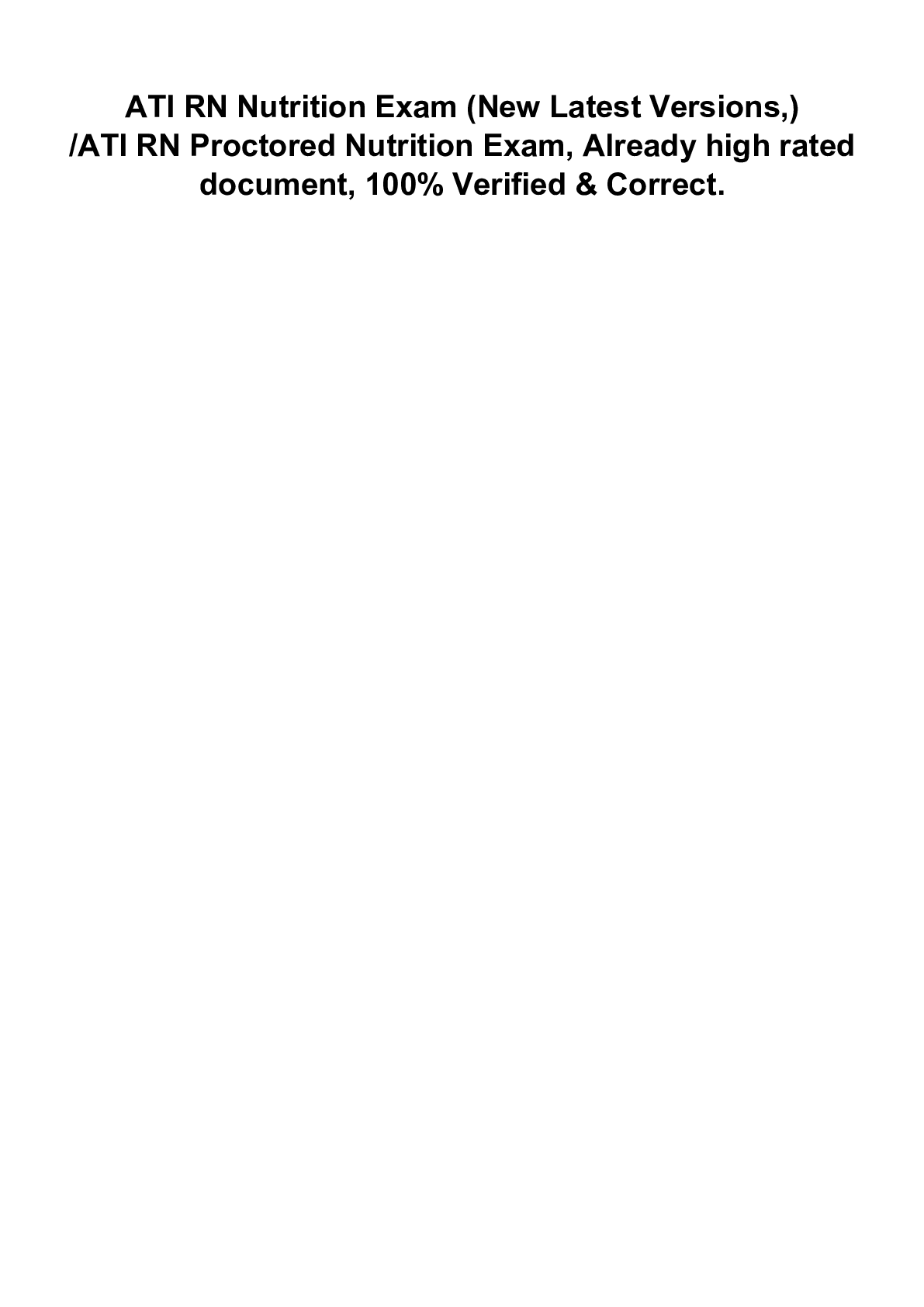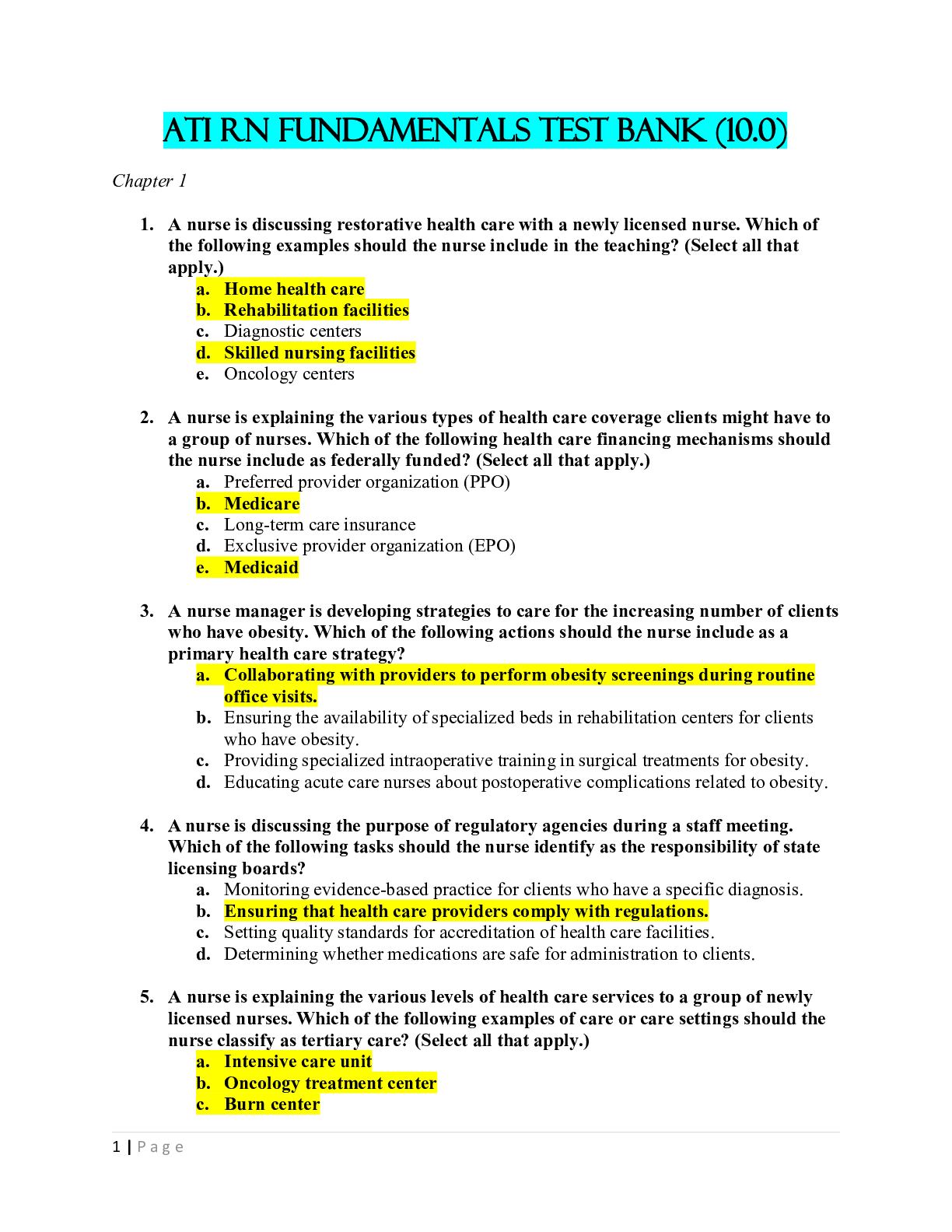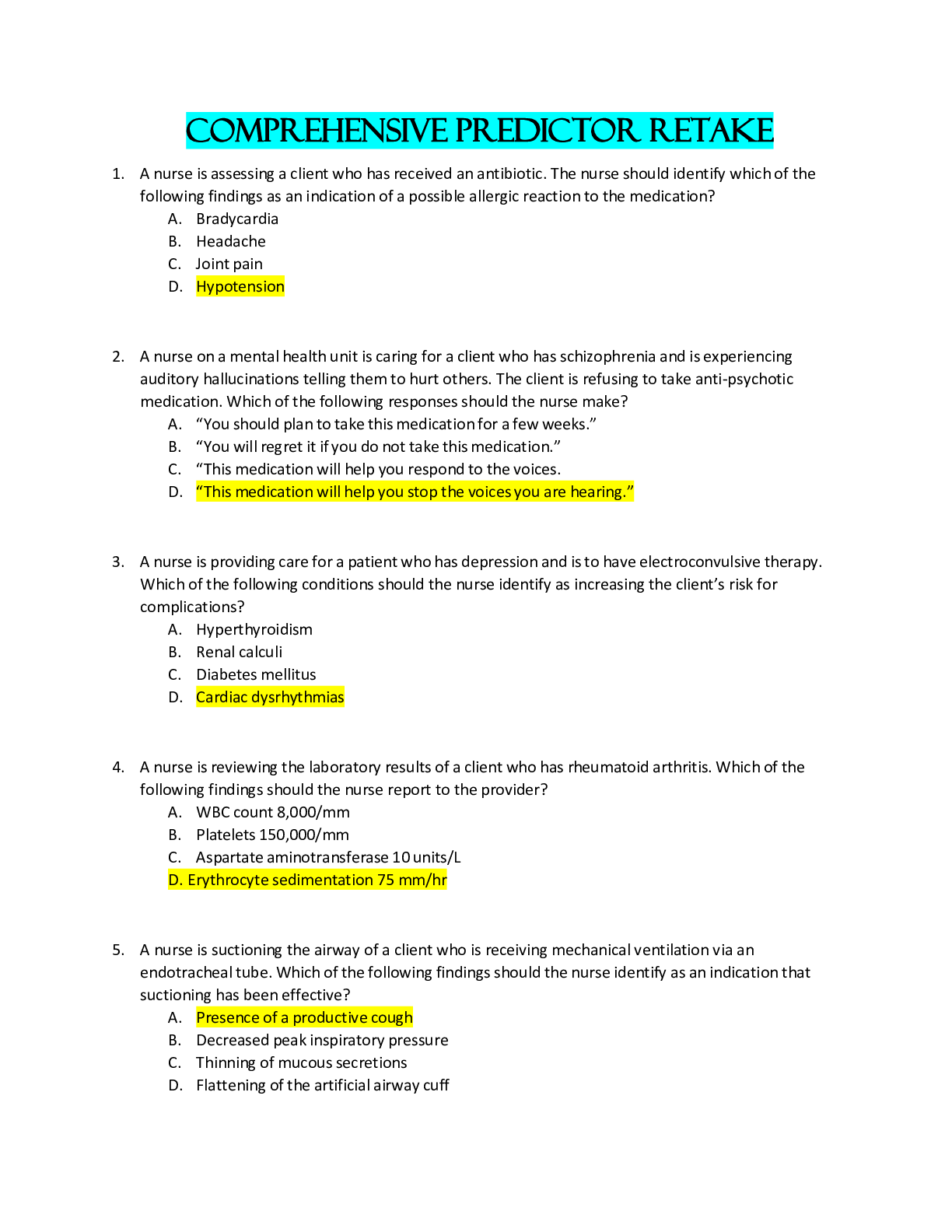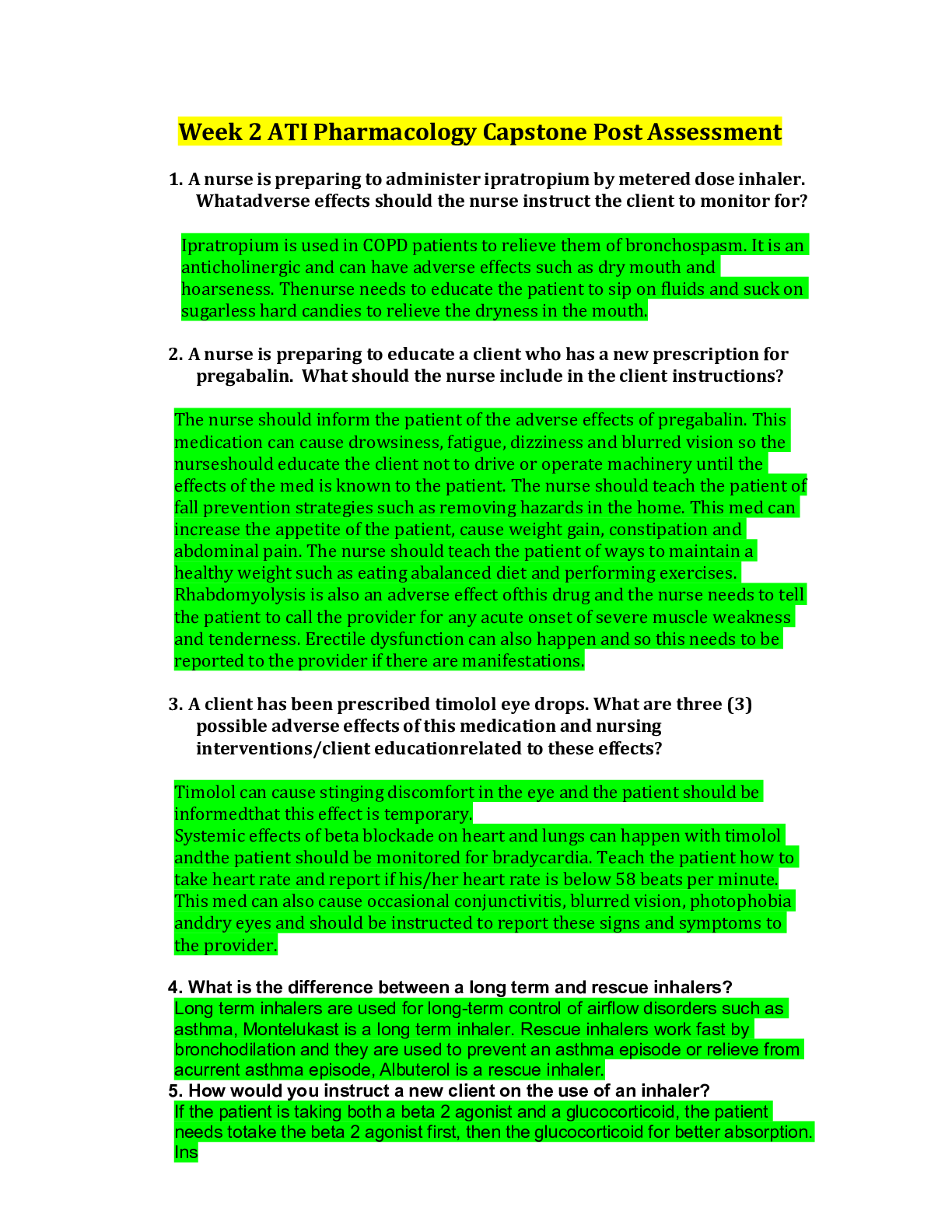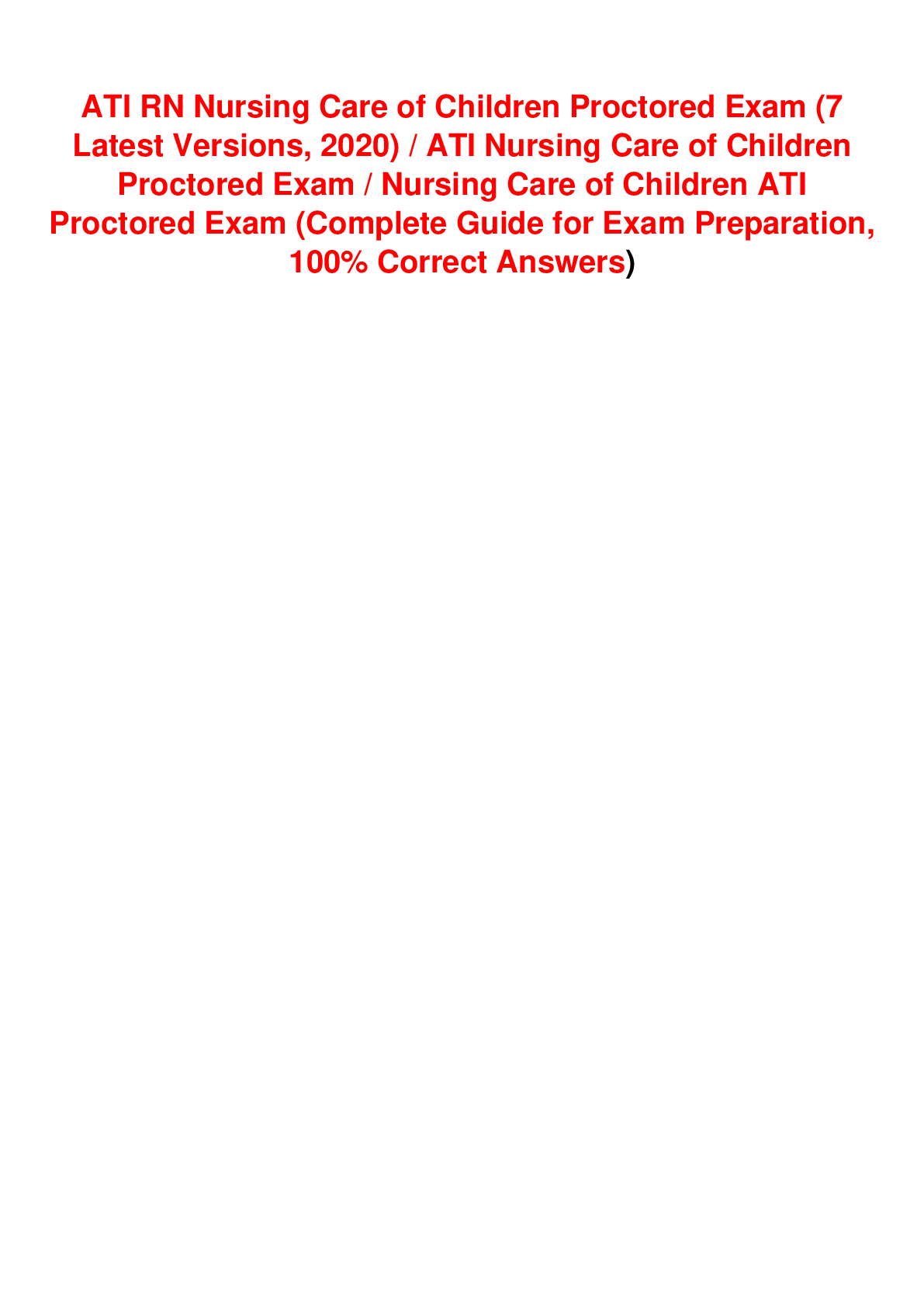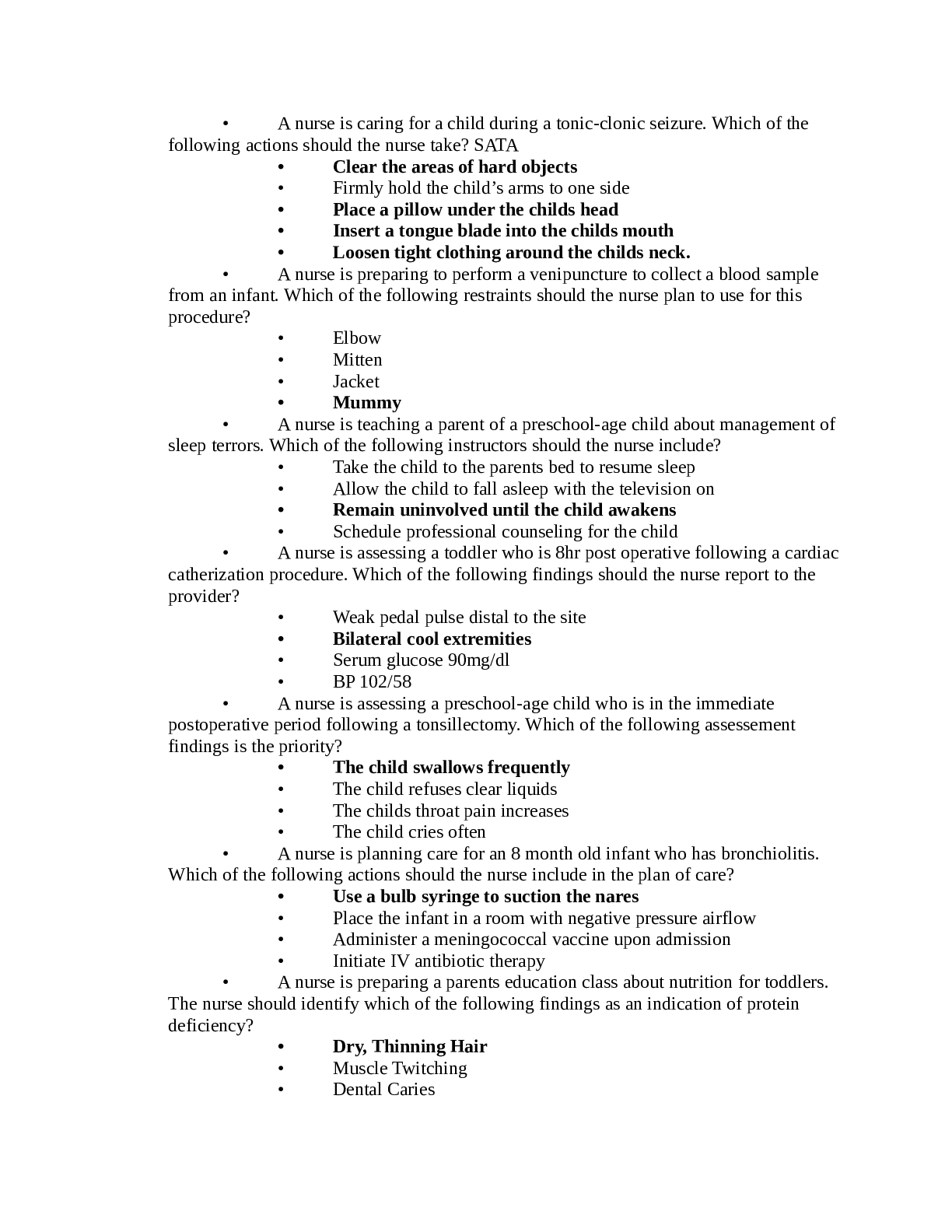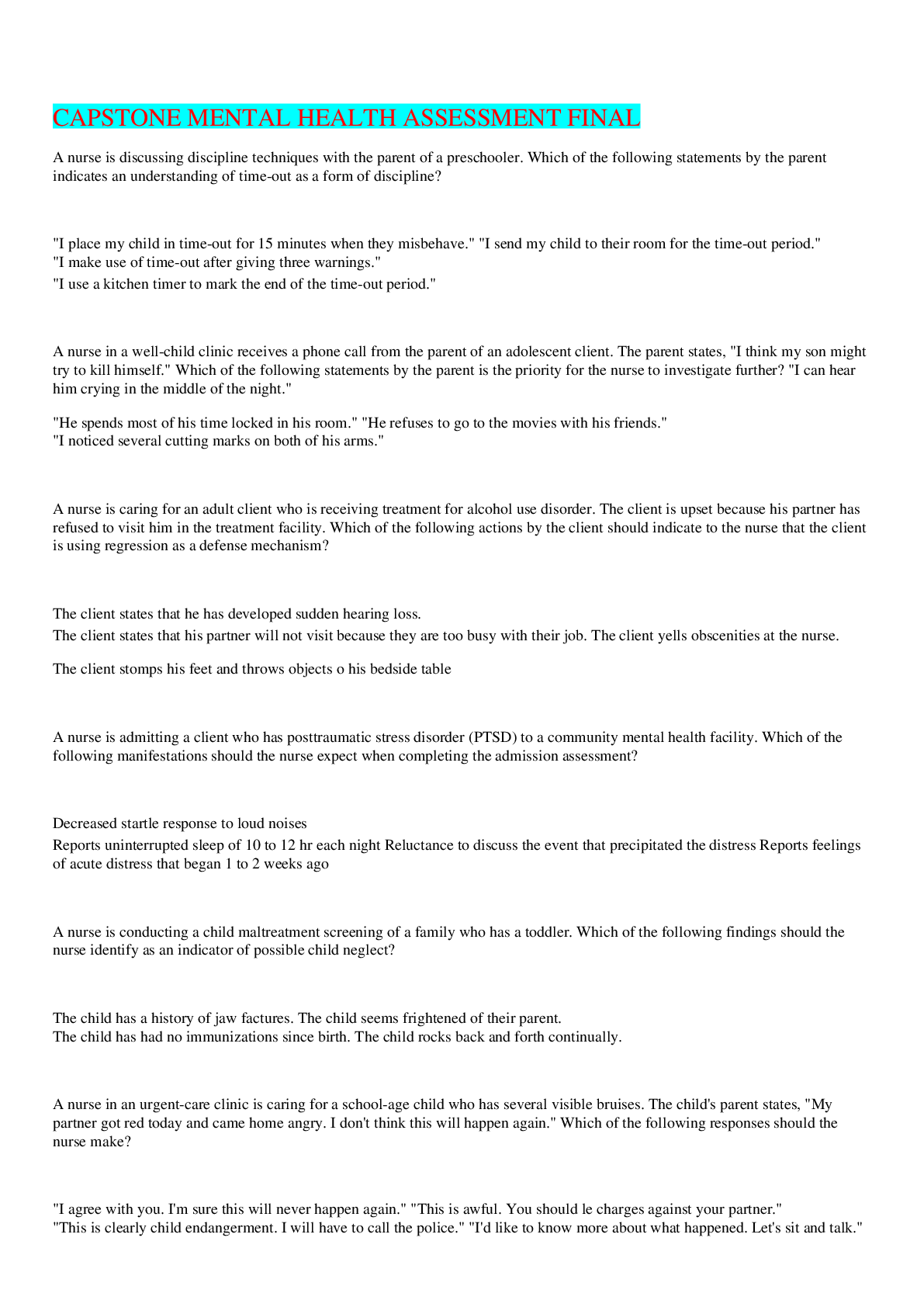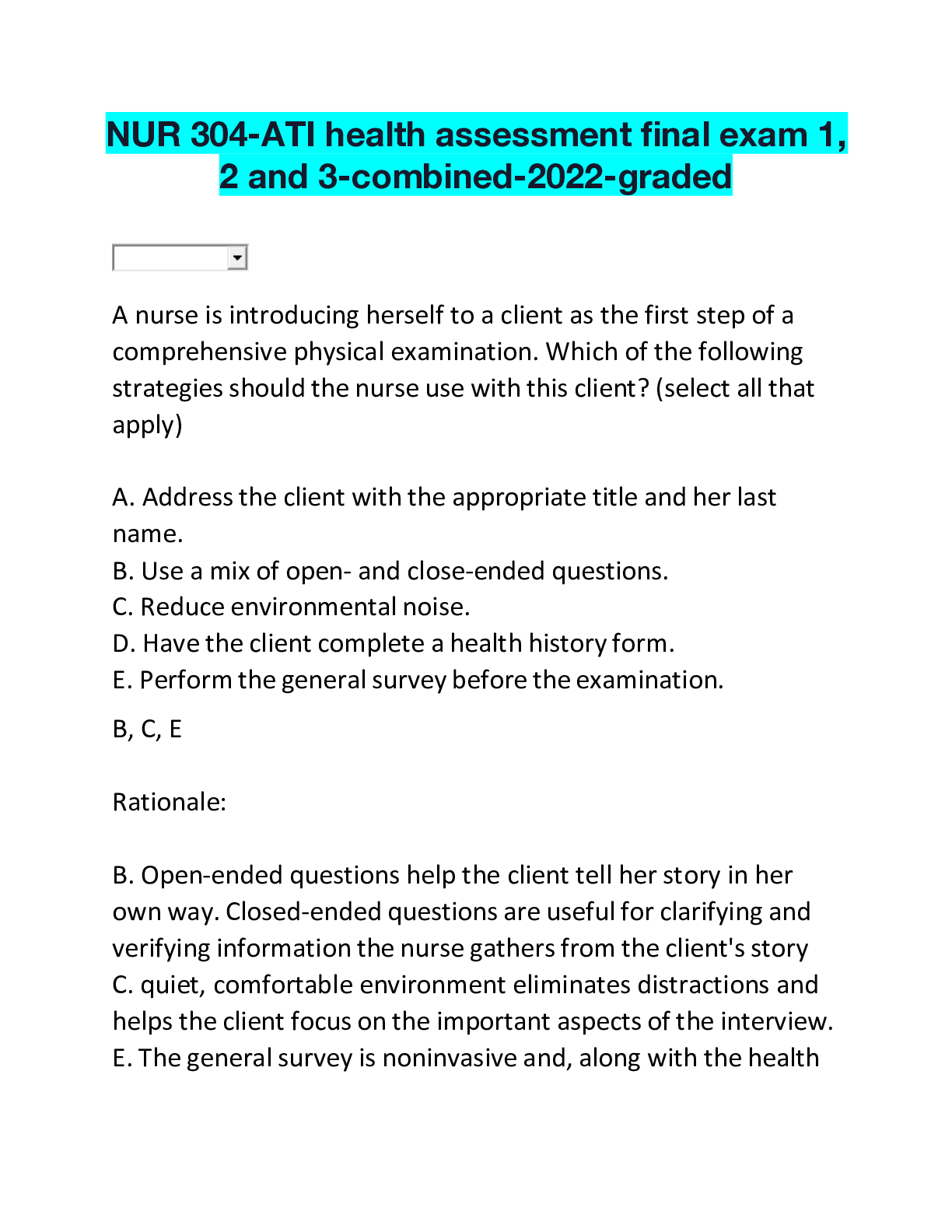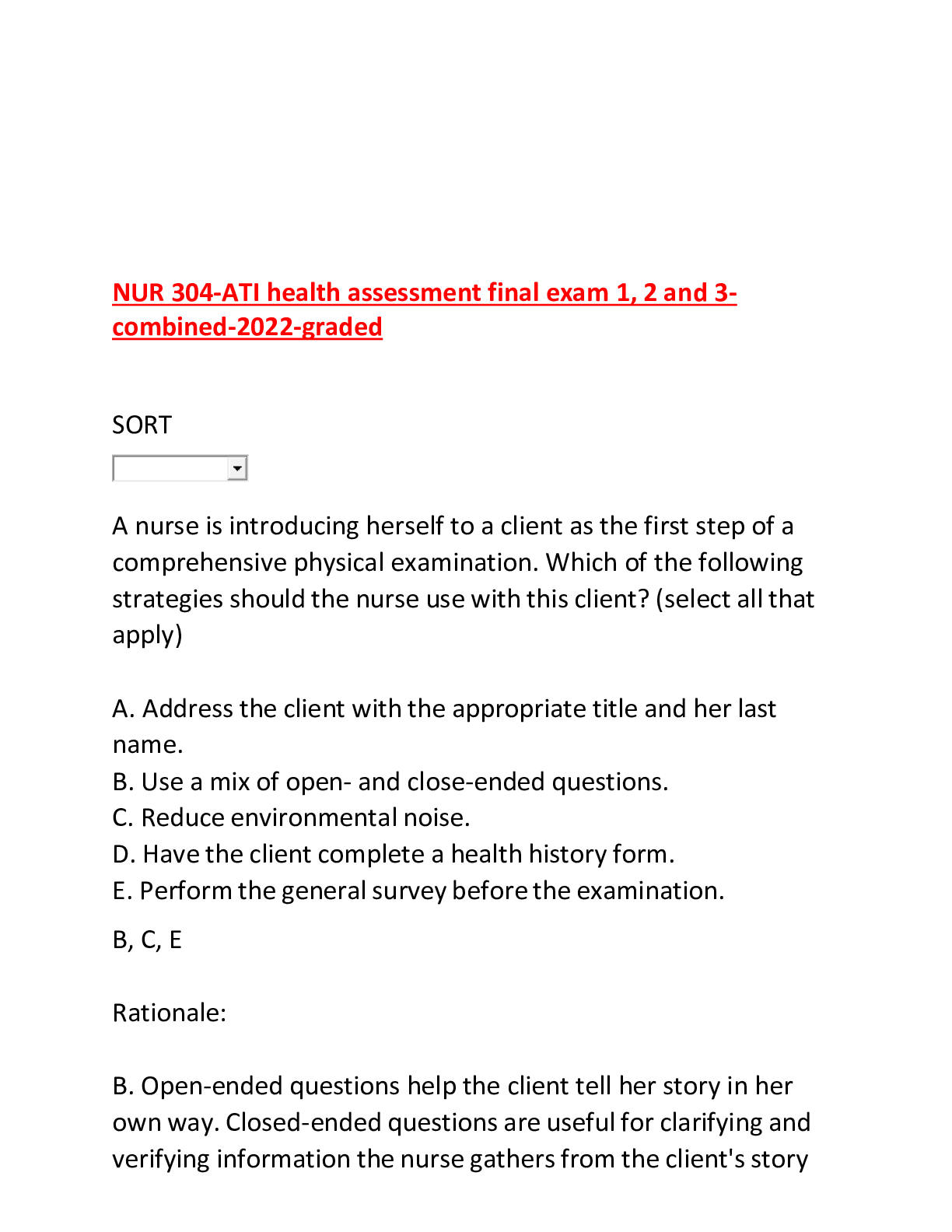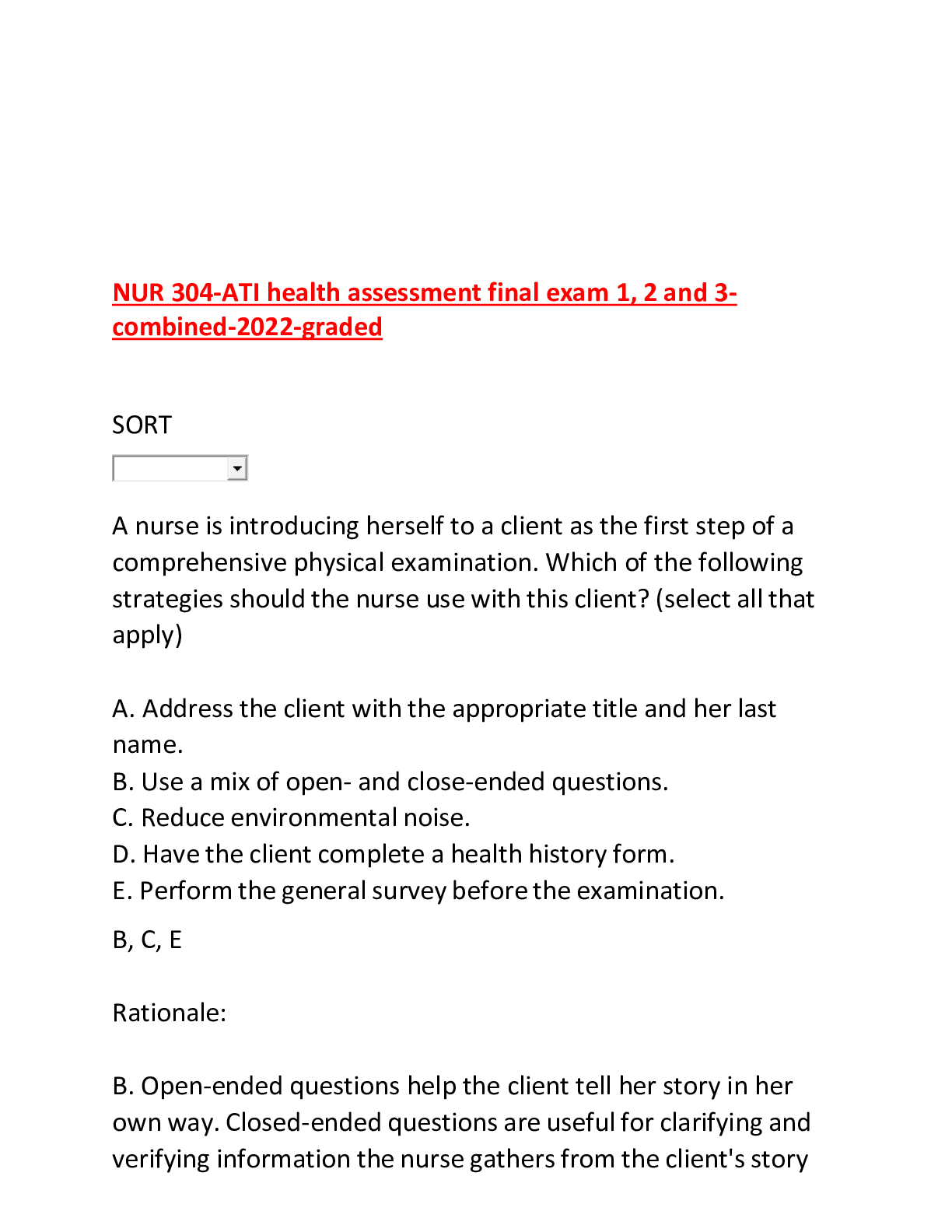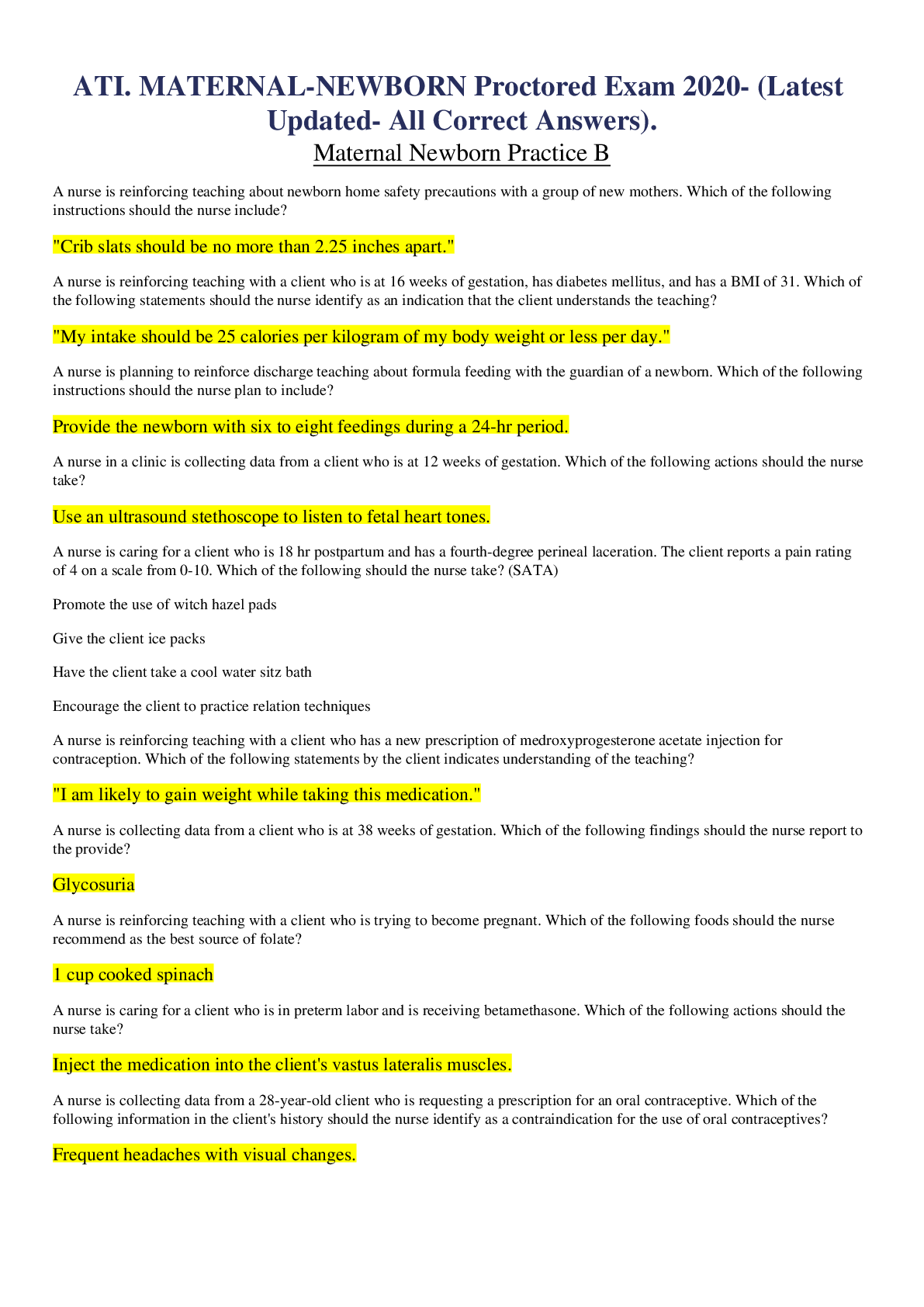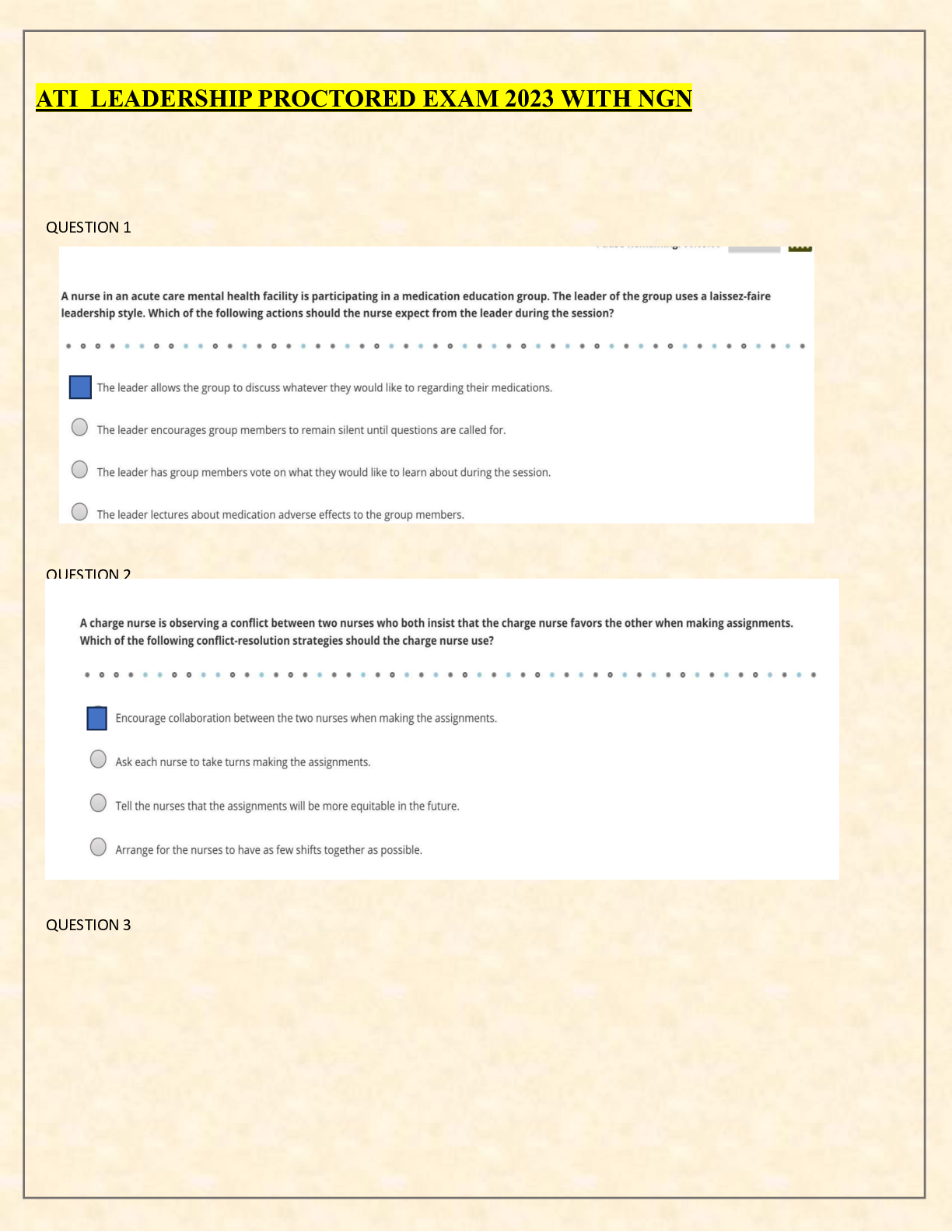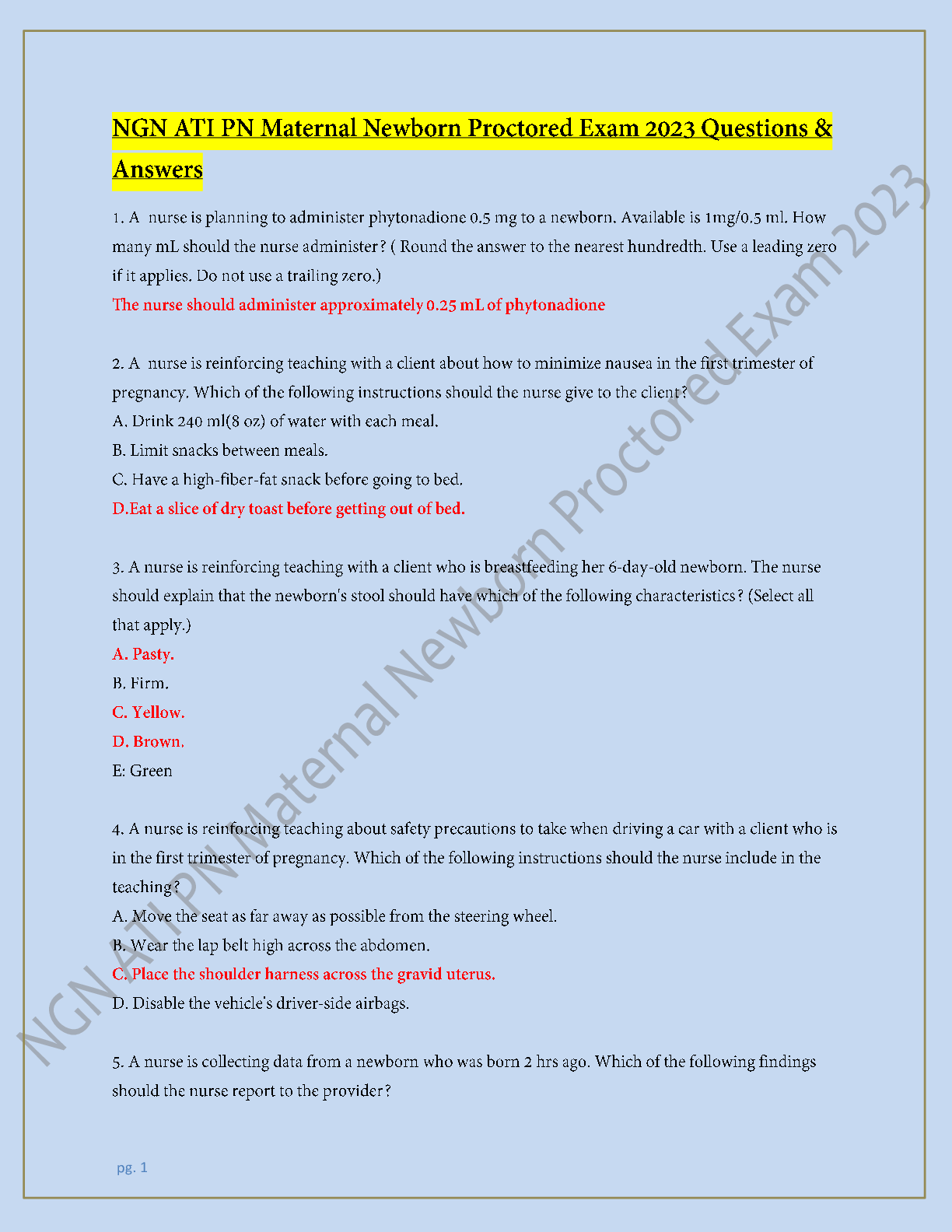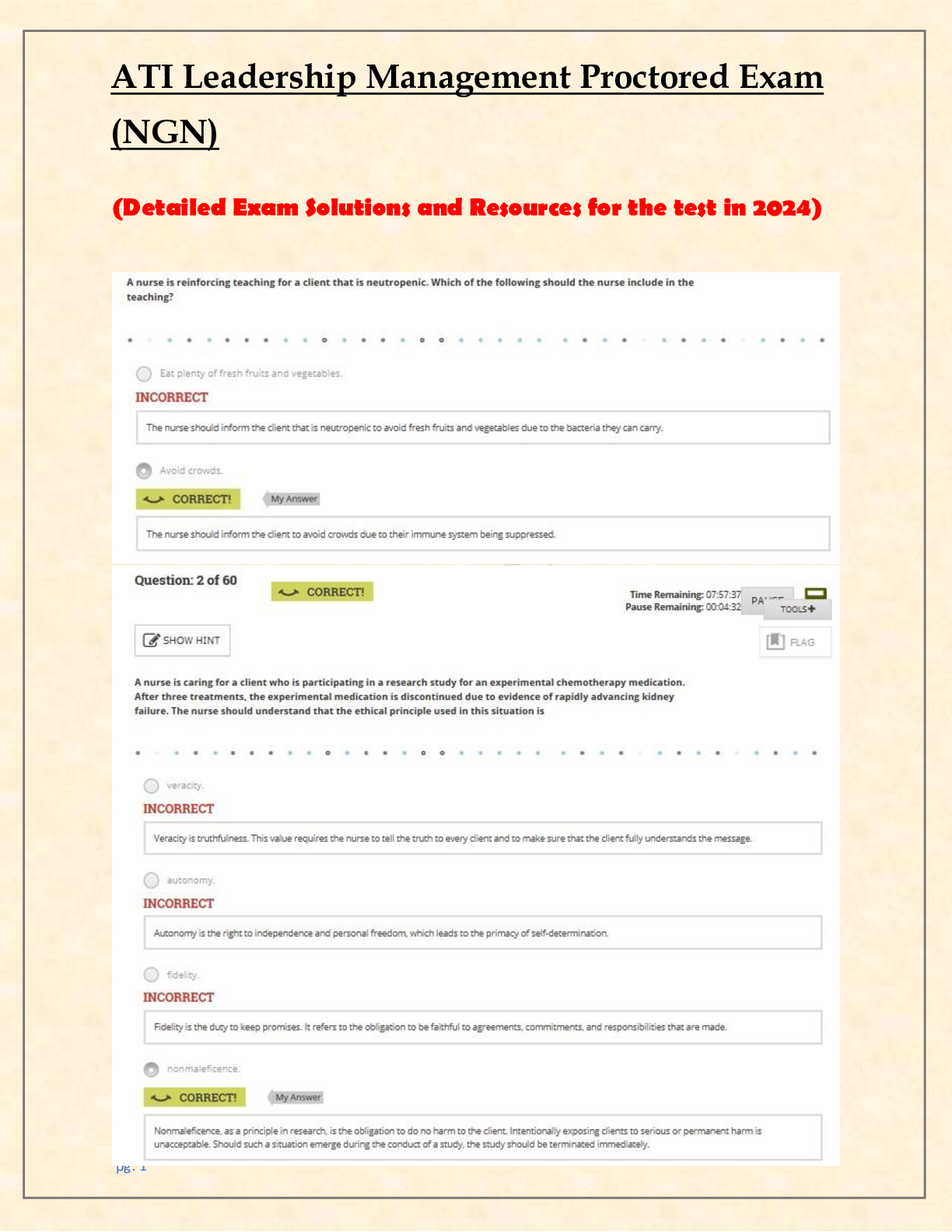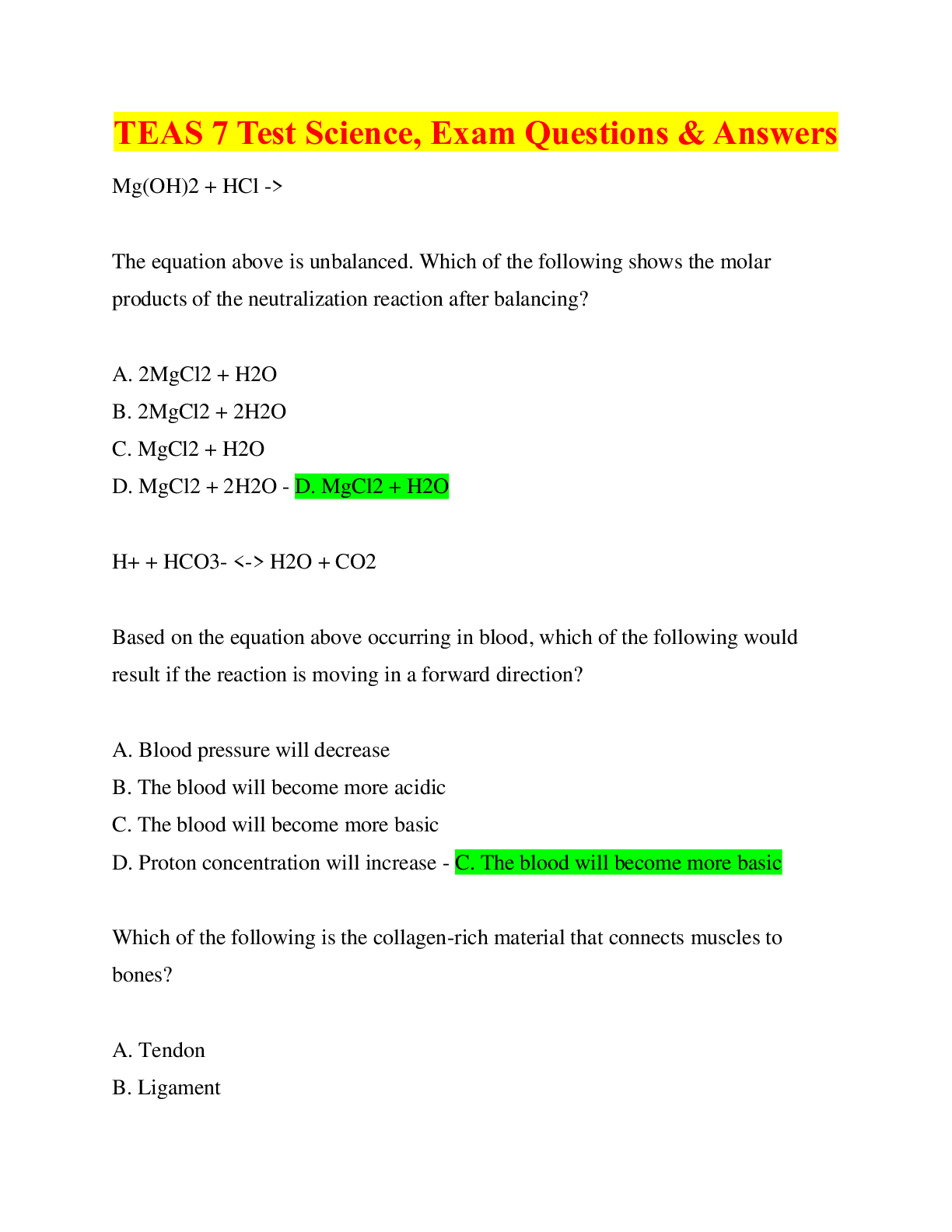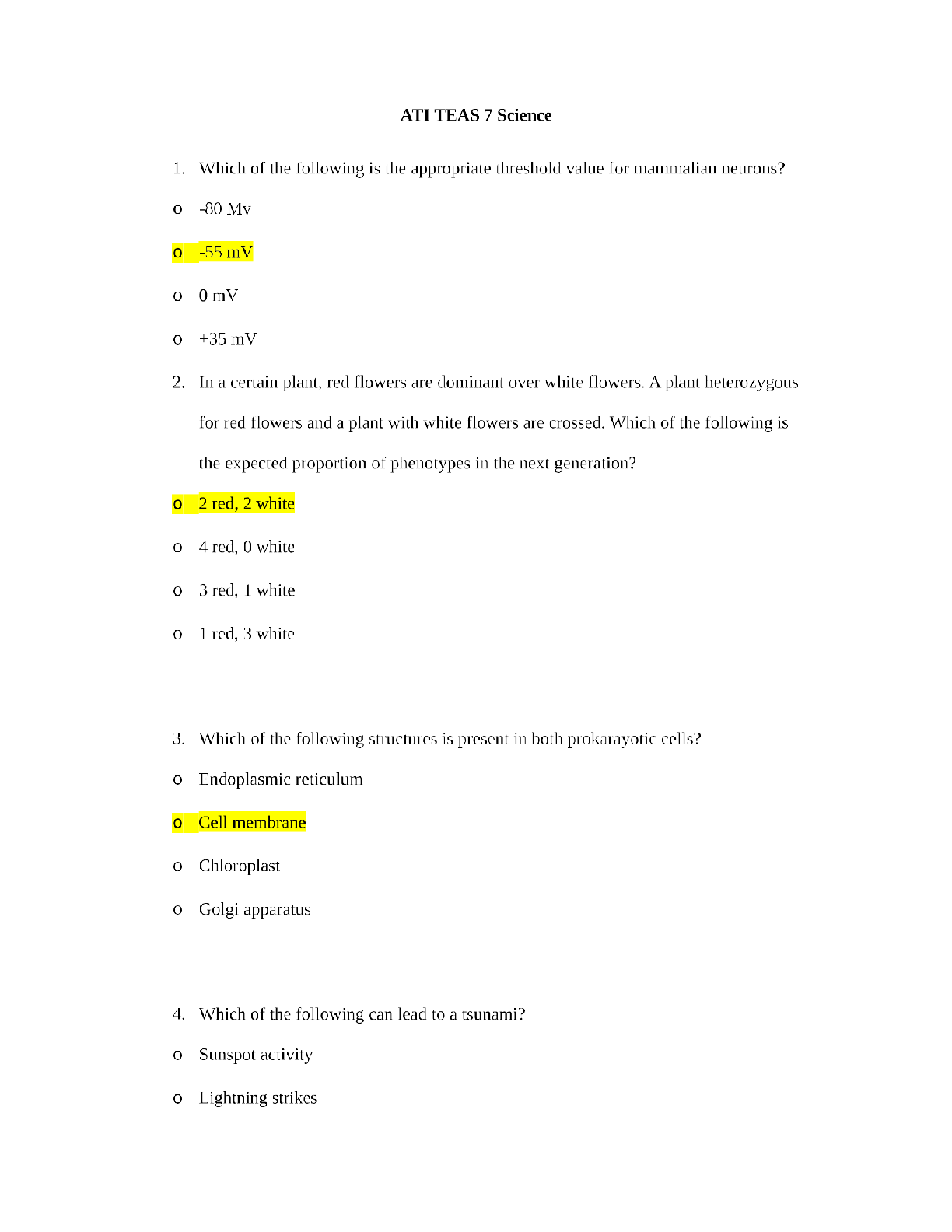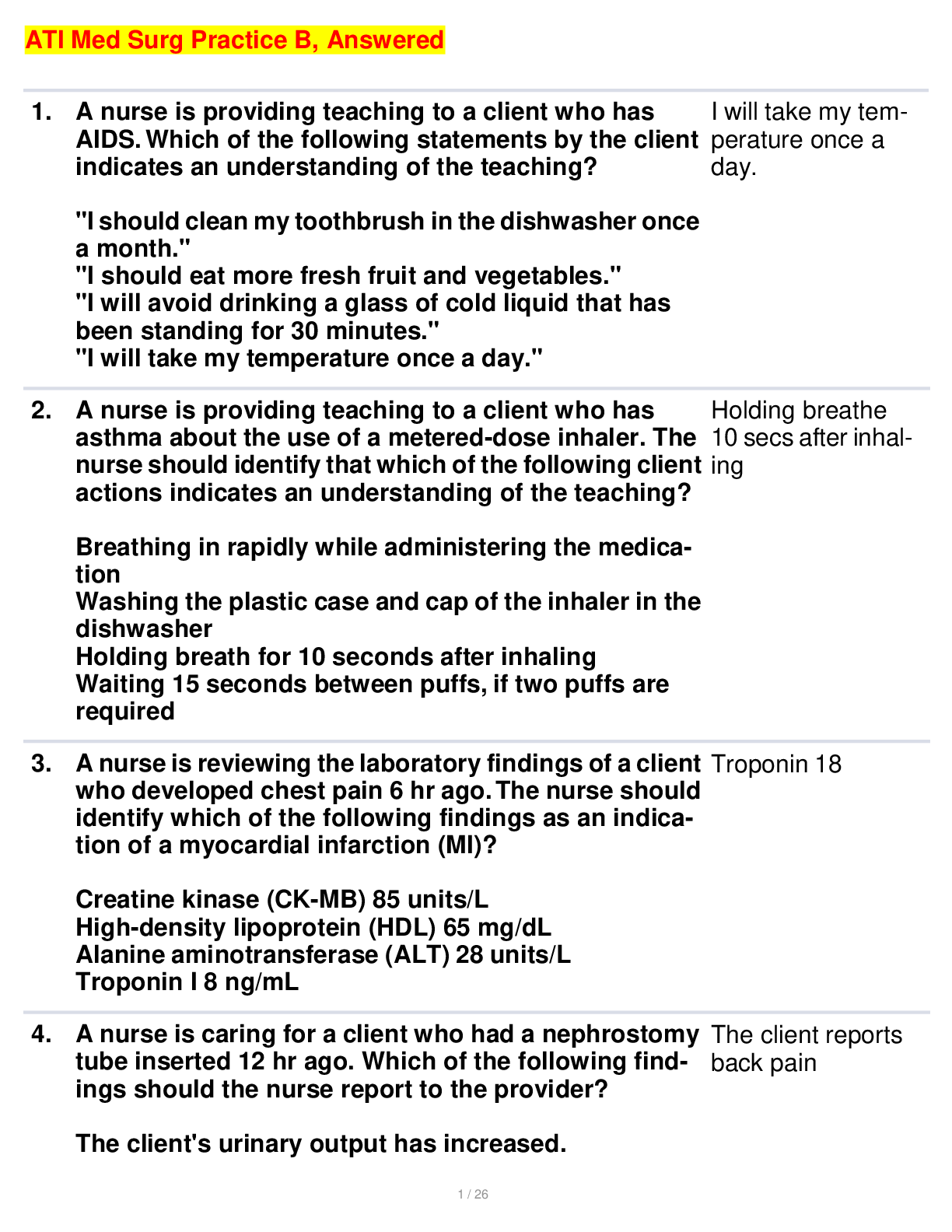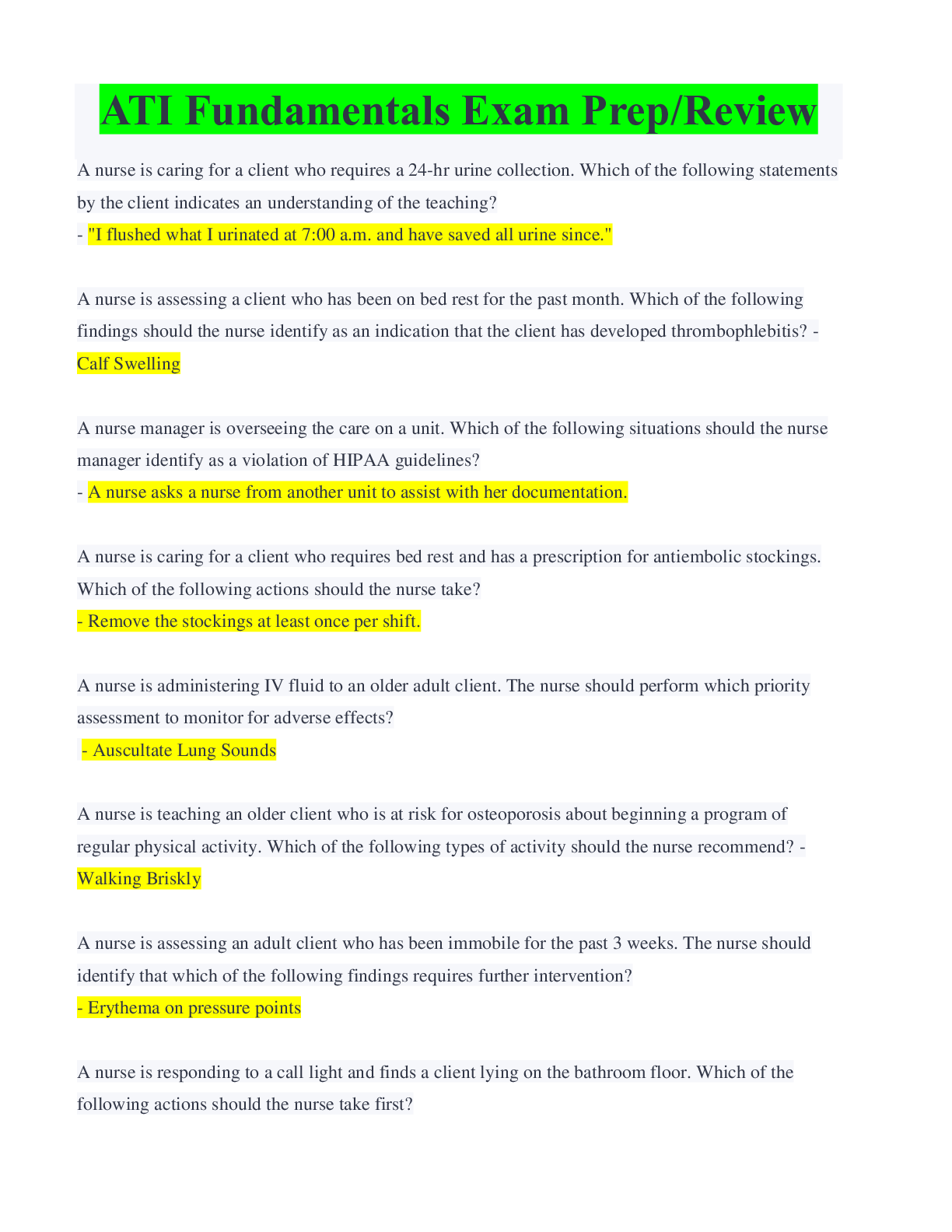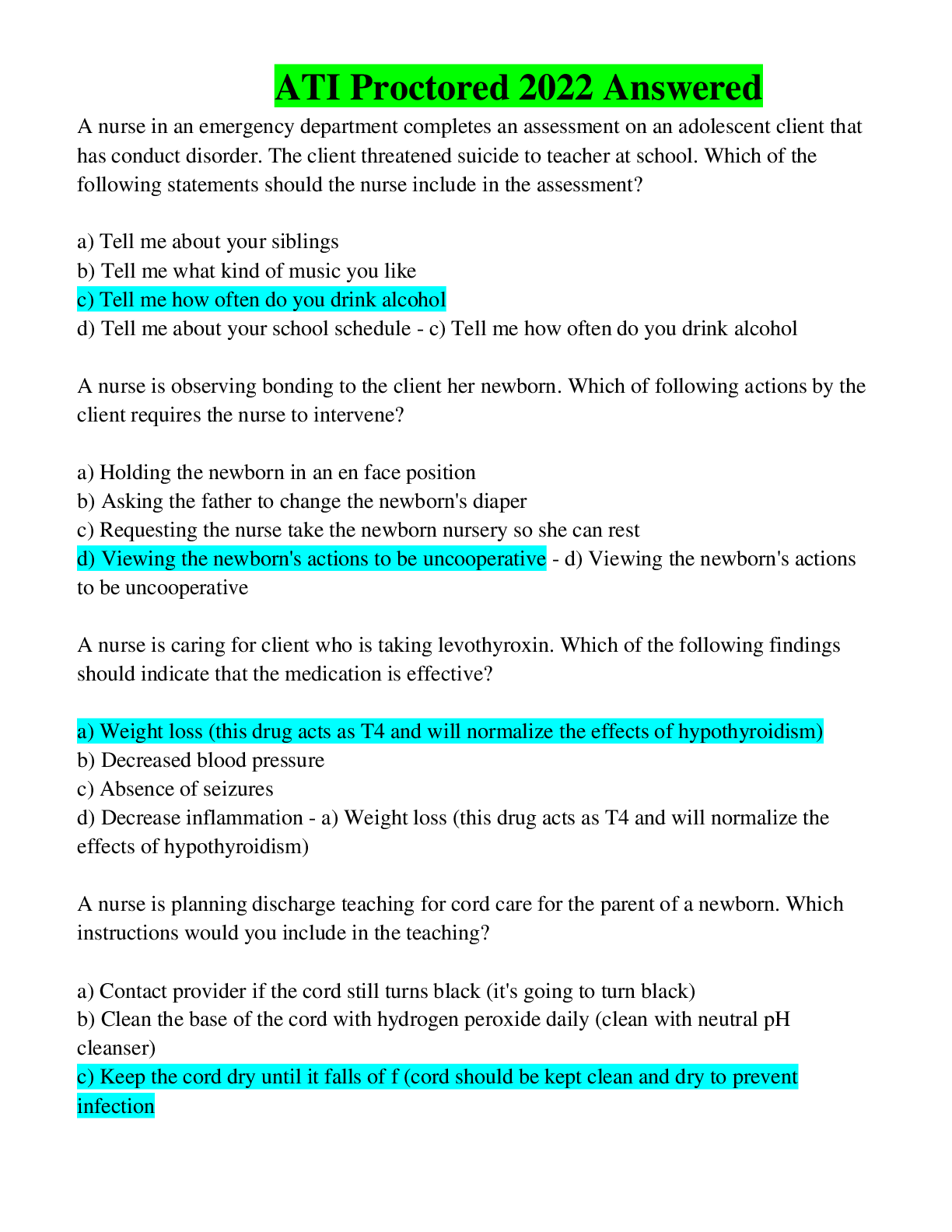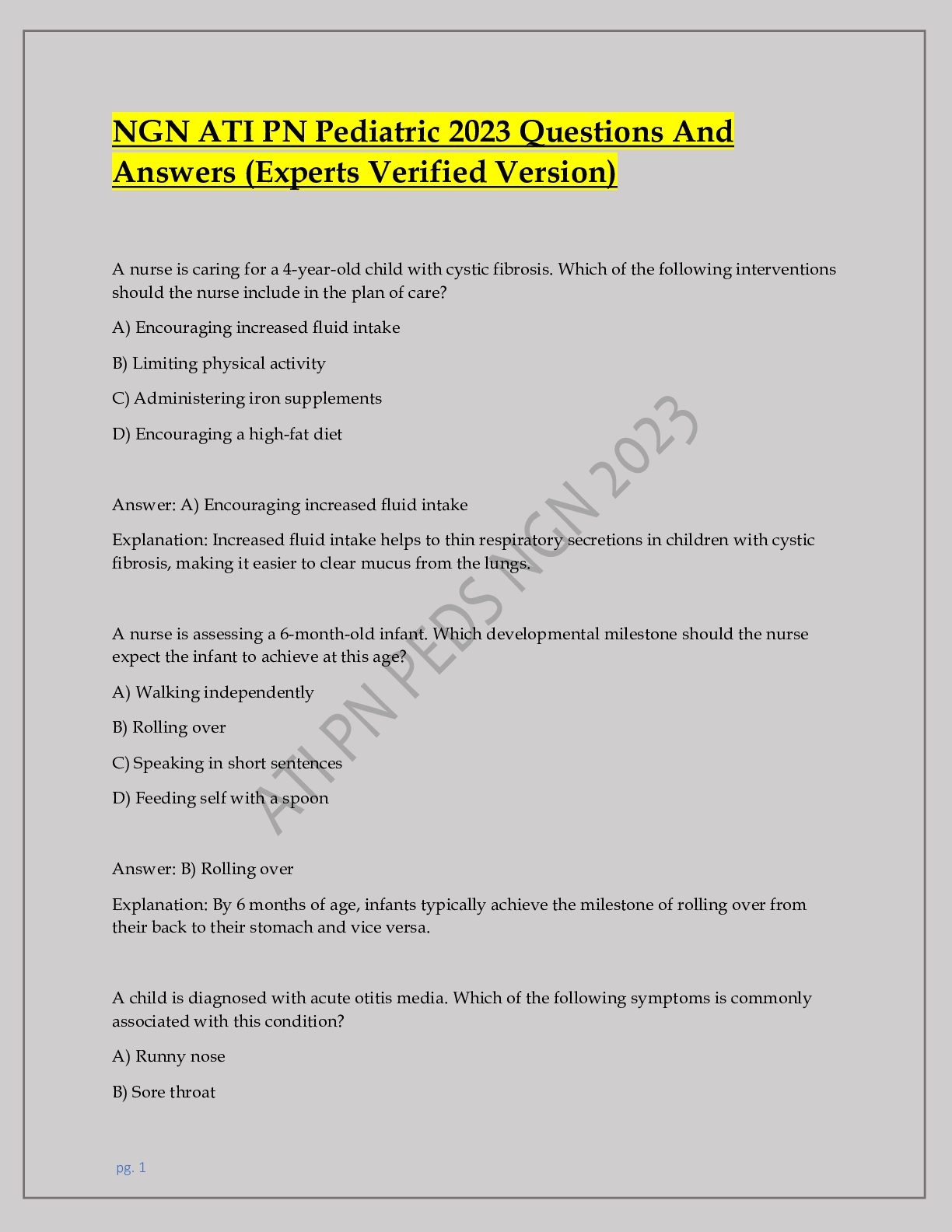ATI HEALTH ASSESSMENT FINAL EXAM 1 Health Assessment ATI EXAM 1
Document Content and Description Below
ATI HEALTH ASSESSMENT FINAL EXAM 1 Health Assessment ATI EXAM 1 1. A nurse is introducing herself to a client as the first step of a comprehensive physical examination. Which of the following strate... gies should the nurse use with this client? (select all that apply) A. Address the client with the appropriate title and her last name. B. Use a mix of open- and close-ended questions. C. Reduce environmental noise. D. Have the client complete a health history form. E. Perform the general survey before the examination. B, C, E Rationale: B. Open ended questions help the client tell her story in her own way. Closed ended questions are useful for clarifying and verifying information the nurse gathers from the client's story C. quiet, comfortable environment eliminates distractions and helps the client focus on the important aspects of the interview. E. The general survey is noninvasive and, along with the health history and vital sign measurement, can help put the client at ease before the more sensitive parts of the process, such as the examination 2. A nurse in a provider's office is documenting his findings following an examination he performed for a client new to the practice. Which of the following parameters should he include as part of the general survey? (Select all that apply.) A. Posture B. Skin lesions C. Speech D. Allergies. E. immunization status A, B, C Rationale: A. Posture is part of the body structure or general appearance portion of the general survey. B. Skin lesions are part of the body structure or general appearance portion of the general survey. C. Speech is part of the behavior portion of the general survey 3. A nurse is collecting data for a client's comprehensive physical examination. after the nurse inspects the client's abdomen, which of the following skills of the physical examination process should she perform next? A.olfaction B.auscultation C.Palpation D.Percussion B Rationale: B. Because palpation and percussion can alter the frequency and intensity of bowel sounds, the nurse should auscultate the abdomen next and before using those two techniques 4. A nurse is performing a comprehensive physical examination of an older adult client. Which of the following interventions should the nurse use in consideration of the client's age? (Select all that apply.) a.Collect the data in one continuous session. B.Plan to allow plenty of time for position changes. C.Make sure the client has any essential sensory aids in place. D. tell the client to take her time answering questions. E. invite the client to use the bathroom before beginning the examination B, C, D, E Rationale: B. Because many older adults have mobility challenges, the nurse should plan to allow extra time for position changes. C. the nurse should make sure clients who use sensory aids have them available for use. the client has to be able to hear the nurse and see well enough to avoid injury. D. Some older clients need more time to collect their thoughts and answer questions, but most are reliable historians. Feeling rushed can hinder communication. E. This is a courtesy for all clients, to avoid discomfort during palpation of the lower abdomen for example, but this is especially important for older clients who have a smaller bladder capacity. 5. A nurse in a family practice clinic is performing a physical examination of an adult client. Which part of her hands should she use during palpation for optimal assessment of skin temperature? A.Palmar surface B.Fingertips C.Dorsal surface D.Base of the fingers C Rationale: C. The dorsal surface of the hand is the most sensitive to temperature. 6. A nurse is caring for an 82 year old client in the emergency department who has an oral body temperature of 38.3° C (101° F), pulse rate 114/min, and respiratory rate 22/min. He is restless and his skin is warm. Which of the following interventions should the nurse take? (Select all that apply.) A.Obtain culture specimens before initiating antimicrobials. B.Restrict the client's oral fluid intake. C.Encourage the client to rest and limit activity. D. allow the client to shiver to dispel excess heat. E. assist the client with oral hygiene frequently A, C, E Rationale: A. he provider can prescribe cultures to identify any infectious organisms causing the fever. the nurse should obtain culture specimens before antimicrobial therapy to prevent interference with the detection of the infection. C. Rest helps conserve energy and decreases metabolic rate. activity can increase heat production E. Oral hygiene helps prevent cracking of dry mucous membranes of the mouth and lips 7. A nurse is instructing an assistive personnel (aP) about caring for a client who has a low platelet count as a result of chemotherapy. Which of the following instructions is the priority for measuring vital signs for this client? A."Do not measure the client's temperature rectally." B."Count the client's radial pulse for 30 seconds and multiply it by 2." C."Do not let the client know you are counting her respirations." D."let the client rest for 5 minutes before you measure her blood pressure." A Rationale: A. The greatest risk to a client who has a low platelet count is an injury that results in bleeding. Using a thermometer rectally poses a risk of injury to the rectal mucosa. the low platelet count contraindicates the use of the rectal route for this client. 8. A nurse is instructing a group of nursing students in measuring a client's respiratory rate. Which of the following guidelines should the nurse include? (Select all that apply.) A.Place the client in semi Fowler's position. B.Have the client rest an arm across the abdomen. C.Observe one full respiratory cycle before counting the rate. D.Count the rate for 30 sec if it is irregular. E.Count and report any sighs the client demonstrates. A, B, C Rationale: A. Having the client sit upright facilitates full ventilation and gives the students a clear view of chest and abdominal movements. B. With the client's arm across the abdomen or lower chest, it is easier for the students to see respiratory movements. C. Observing for one full respiratory cycle before starting to count assists the students in obtaining an accurate count. D. the students should count the rate for 1 min if it is irregular 9. A nurse who is admitting a client who has a fractured femur obtains a blood pressure reading of 140/94 mm Hg. the client denies any history of hypertension. Which of the following actions should the nurse take first? A.Request a prescription for an antihypertensive medication. B. ask the client if she is having pain. C.Request a prescription for an anti-anxiety medication. D.Return in 30 min to recheck the client's blood pressure B Rationale: B. The first action the nurse should take using the nursing process is to assess the client for pain which can cause multiple complications, including elevated blood pressure. therefore, the nurse's priority is to perform a pain assessment. if the client's blood pressure is still elevated after pain interventions, the nurse should report this finding to the provider. 10. A nurse is performing an admission assessment on a client. the nurse determines the client's radial pulse rate is 68/min and the simultaneous apical pulse rate is 84/min. What is the client's pulse deficit? 16/min the pulse deficit is the difference between the apical and radial pulse rates. it reflects the number of ineffective or non perfusing heartbeats that do not transmit pulsations to peripheral pulse points. 84 68 = 16 11. A nurse at a clinic is collecting data about pain from of a client who reports severe abdominal pain. the nurse asks the client whether he has nausea and has been vomiting. Which of the following pain characteristics is the nurse attempting to determine? A.Presence of associated manifestations B.Location of the pain C.Pain quality D. aggravating and relieving factors A Rationale: A. The nurse should attempt to identify manifestations that occur along with the clients pain, such as nausea, fatigue or anxiety. 12. A nurse is collecting data from a client who is reporting pain despite taking analgesia. Which of the following actions should the nurse take to determine the intensity of the client's pain? A. ask the client what precipitates the pain. B.Question the client about the location of the pain. C.Offer the client a pain scale to measure his pain. D.Use open ended questions to identify the client's pain sensations. C Rationale: C. The nurse should use a pain rating scale to help the client report the intensity of his pain. the nurse should use a numeric, verbal, or visual analog scale appropriate to the client's individual needs. 13. A nurse is discussing the care of a group of clients with a newly licensed nurse. Which of the following clients should the newly licensed nurse identify as experiencing chronic pain? A. a client who has a broken femur and reports hip pain. B. a client who has incisional pain 72 hr following pacemaker insertion. C. a client who has food poisoning and reports abdominal cramping. D. a client who has episodic back pain following a fall 2 years ago D Rationale: D. A client who reports pain that lasts more than 6 months and continues beyond the time of tissue healing is experiencing chronic pain. the nurse should identify this client's pain as chronic, and assist with planning interventions to relieve manifestations associated with the pain 14. A nurse is monitoring a client who is receiving opioid analgesia for adverse effects of the medication. Which of the following effects should the nurse anticipate? (Select all that apply.) a.Urinary incontinence B.Diarrhea C.Bradypnea D.Orthostatic hypotension e. nausea C, D, E Rationale: C.Opioid analgesia can cause respiratory depression, which causes respiratory rates to drop to dangerously low levels. the nurse should monitor the client's respiratory rate, and administer naloxone if indicated. D. Opioid analgesia can cause orthostatic hypotension. the nurse should monitor the client for dizziness or lightheadedness when changing positions. E. Opioid analgesia can cause nausea and vomiting. the nurse should monitor for and treat these complications as needed. 15. A nurse is caring for a client who is receiving morphine via a patient controlled analgesia (PCA) infusion device after abdominal surgery. Which of the following statements indicates that the client knows how to use the device? A."i'll wait to use the device until it's absolutely necessary." B."i'll be careful about pushing the button too much so idon't get an overdose." C."i should tell the nurse if the pain doesn't stop while i am using this device." D."i will ask my adult child to push the dose button when i am sleeping." C Rationale: C. PCA allows the client to self administer pain medication on an as needed basis. if the client is not achieving adequate pain control, he should let the nurse know so that she can initiate a reevaluation of the client's pain management plan and possible dosage change. 16. A nurse is using an interpreter to communicate with a client. Which of the following actions should the nurse use when communicating with a client and his family? (Select all that apply.) A. talk to the interpreter about the family while the family is in the room. B. ask the family one question at a time. C. look at the interpreter when asking the family questions. D. use lay terms if possible. E. do not interrupt the interpreter and the family as they talk B, D, E Rationale: B. Asking the family one question at a time will promote effective communication between the family and the nurse/interpreter. D.using lay terms will promote effective communication between the family and the nurse/interpreter. E.not interrupting will promote effective communication between the family and the nurse/interpreter. 17. A nurse is caring for a client who shares the nurse's religious background. Which of the following information should the nurse anticipate A.Members of the same religion share similar feelings about their religion. B. a shared religious background generates mutual regard for one another. C. the same religious beliefs can influence individuals differently. D. the nurse and client should discuss the differences and commonalities in their beliefs C Rationale: C.Members of any particular religion should be assessed for individual feelings and ideas 18. A nurse is caring for a client who is crying while reading from his devotional book. Which of the following interventions should the nurse take? A.Contact the hospital's spiritual services. B. ask him what is making him cry. C. provide quiet times for these moments. d. turn on the television for a distraction C Rationale: C. Providing privacy and time for the reading of religious materials supports the client's spiritual health. 19. A nurse is planning care for a client who is a devout Muslim and is 3 days postoperative following a hip arthroplasty. the client is scheduled for two physical therapy sessions today. Which of the following statements by the nurse indicates culturally appropriate care to the client? A."i will make sure the menu includes kosher options." B."i will discuss the daily schedule with the client to make sure the client will have time for prayer." C."i will make sure to use direct eye contact when speaking with this client." D."i will make sure daily communion is available for this client." B Rationale: B.Devout Muslims pray five times per day. Without proper awareness and planning, the client can refuse necessary treatments, such as physical therapy, if adequate prayer times are not planned for and incorporated into the client's day 20. A nurse is caring for a client who is a Jehovah's Witness and is scheduled for surgery as a result of a motor vehicle crash. the surgeon tells the client that a blood transfusion is essential. the client tells the nurse that based on his religious values and mandates, he cannot receive a blood transfusion. Which of the following responses should the nurse make? A."i believe in this case you should really make an exception and accept the blood transfusion." B."i know your family would approve of your decision to have a blood transfusion." C."Why does your religion mandate that you cannot receive any blood transfusions?" D."let's discuss the necessity for a blood transfusion with your religious and spiritual leaders and come to a reasonable solution." D Rationale: D. Involving the client's religious and spiritual leaders is a culturally responsive action at this point. alternative forms of blood products can be discussed, and a plan reasonable to all can be reached 21. A nurse is caring for a client who states, "i have to check with my wife and see if she thinks i am ready to go home." The nurse replies, "how do you feel about going home today?" Which clarifying technique is the nurse using to enhance communication with the client? A. pacing B. reflecting C. paraphrasing D. restating B Rationale: B. reflecting defects the focus on the conversation back to the client so that he can further explore his feelings. 22. Which of the following actions should the nurse take when using the communication technique of active listening? (Select all that apply.) A. use an open posture. B.Write down what the client says to avoid forgetting details. C. establish and maintain eye contact. D. nod in agreement with the client throughout the conversation. E. respond positively when giving feedback. A, C, E Rationale: A/C. Having an open posture m facing the client, and leaning forward are ways the nurse can demonstrate active listening E. responding positively when giving feed back demonstrates active listening 23. A nurse is caring for a client who is concerned about his impending discharge to home with a new colostomy because he is an avid swimmer. Which of the following statements should the nurse make? (Select all that apply.) A."You will do great! You just have to get used it." B."Why are you worried about going home?" C."Your daily routines will be different when you get home." D."Tell me about your support system you'll have after you leave the hospital." E."Let me tell you about a friend of mine with a colostomy who also enjoys swimming." C, D, E Rationale: C.presenting reality is an effective communication technique that can help the client focus on what will really happen after the changes the surgery has made. D. asking open ended questions and offering general leads and broad opening statements are effective communication techniques that encourage the client to express feelings through dialogue and offer additional information. E. offering self is an effective communication technique that can convey understanding and share another's experience with the client. however, the nurse should return the focus to the client as soon as she communicates the relevant point 24. Which of the following strategies should a nurse use to establish a helping relationship with a client? A. make sure the communication is equally reciprocal between the nurse and the client. B. encourage the client to communicate his thoughts and feelings. C.Give the nurse client communication no time limits. D. allow communication to occur spontaneously throughout the nurse client relationship B Rationale: B. Therapeutic communication facilitates a helping relationship that maximizes the client's ability to express his thoughts and feelings openly 25. A nurse is caring for a school age child who is sitting in a chair. To facilitate effective communication, which of the following actions should the nurse take? A.Touch the child's arm. B.Sit at eye level with the child. C.Stand facing the child. D.Stand with a relaxed posture B Rationale: B. The nurse should be at the same eye level as the child to facilitate communication 26. A nurse in a provider's office is preparing to assess a young adult male client's musculoskeletal system as part of a comprehensive physical examination. Which of the following findings should the nurse expect? (select all that apply.) A. concave thoracic spine posteriorly B. exaggerated lumbar curvature C. concave lumbar spine posteriorly D. exaggerated thoracic curvature E. Muscles slightly larger on his dominant side C, E Rationale: C. The nurse should expect the client to have a concave lumbar spine posteriorly. E. The nurse should expect the client to have muscle size equal on both sides or slightly larger on the dominant side. 27. A nurse is assessing a client's neurosensory system. to evaluate stereognosis, the nurse should ask the client to close his eyes and identify which of the following items? A. a word she whispers 30 cm from his ear B. a number she traces on the palm of his hand C. the vibration of a tuning fork she places on his foot D. a familiar object she places in his hand D Rationale: D.Identifying a familiar object in the hand confirms the client's sense of stereognosis, which is tactile recognition 28. A nurse is caring for a client who reports pain with internal rotation of her right shoulder. the nurse should identify that this discomfort can affect the client's ability to perform which of the following activities? A.Mopping her floors B.Brushing the back of her hair C.Fastening her bra behind her back D. reaching into a cabinet above her sink C Rationale: C. The client who is fastening a bra from behind requires internal rotation of the shoulder, so this activity will elicit pain. 29. A nurse is performing a neurosensory examination for a client. Which of the following assessments should the nurse perform to test the client's balance? (select all that apply.) A. romberg test B. Heel to toe walk C. snellen test D. spinal accessory function E. rosenbaum test A, B Rationale: A. for the Romberg test, the client stands with his eyes closed, arms at his side, and feet together. the nurse verifies balance if the client can stand with minimal swaying for at least 5 seconds. B. For the heel to toe walk, the client places the heel of one foot in front of the toes of the other foot as he walks in a straight line. the nurse verifies balance if the client can walk in a straight line without losing his balance [Show More]
Last updated: 1 year ago
Preview 1 out of 5 pages
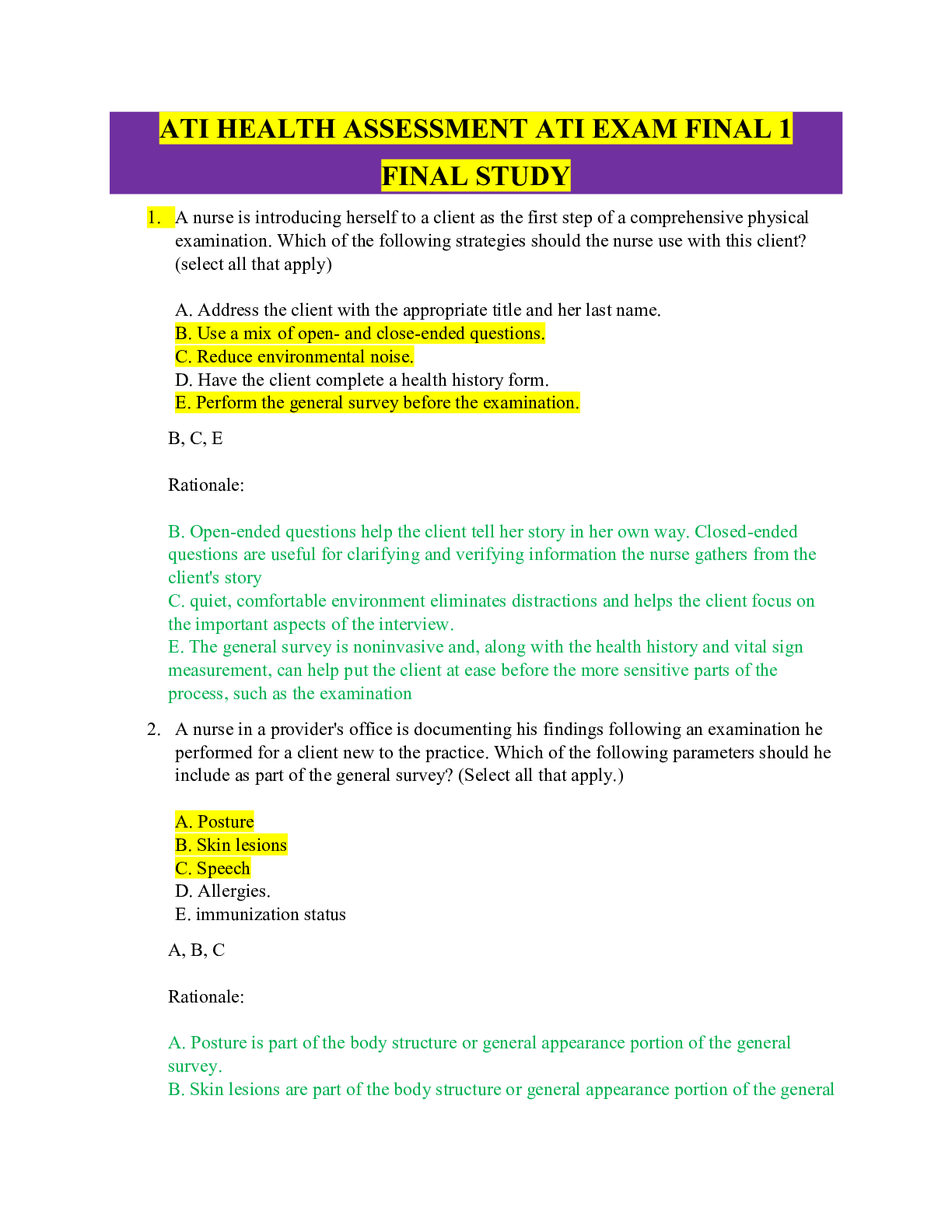
Reviews( 0 )
Document information
Connected school, study & course
About the document
Uploaded On
Nov 22, 2022
Number of pages
5
Written in
Additional information
This document has been written for:
Uploaded
Nov 22, 2022
Downloads
0
Views
49

